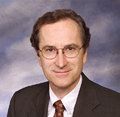ArcNews Online
Fall 2010
[an error occurred while processing this directive]Space-Time Integration in GIS and GIScience
"Crossing Borders"
by Doug Richardson, Executive Director, Association of American Geographers
 Every year, the Association of American Geographers (AAG) identifies a particularly timely or relevant set of themes to feature during its Annual Meetings. Last year, an overriding theme was climate change, for example, and previous years have included featured sessions on topics such as human rights, landscape and literature, sustainable development in Africa, geography of water, and many other topics.
Every year, the Association of American Geographers (AAG) identifies a particularly timely or relevant set of themes to feature during its Annual Meetings. Last year, an overriding theme was climate change, for example, and previous years have included featured sessions on topics such as human rights, landscape and literature, sustainable development in Africa, geography of water, and many other topics.
A special symposium—focused on the research status, recent advances, and research needs of space-time integration, modeling, and analysis in geography and GIScience—will be organized within the AAG Annual Meeting in Seattle, Washington, April 12–16, 2011. This special set of invited papers will feature many leading GIScience researchers from Asia and Europe, as well as from other regions of the world, and will form a high-profile international symposium within the AAG Annual Meeting.
Space-time analysis is a rapidly growing research frontier in geography, GIS, and GIScience. Advances in integrated GPS/GIS technologies; the availability of large datasets (over time and space); and increased capacity to manage, integrate, model, and visualize complex data in (near) real time offer the GIS and geography communities extraordinary opportunities to begin to integrate sophisticated space-time analysis and models in the study of complex environmental and social systems, from climate change to infectious disease transmission.
This special symposium will build on momentum generated from a space-time analysis workshop cosponsored by the AAG, the University of Redlands, the University of Southern California, and Esri in early 2010, as well as from several other initiatives during the past few years. GIScientists, geographers, modelers, computer programmers, GPS/GIS systems scientists, climate change scientists, epidemiologists, ecologists, planners, transportation experts, and others with active research expertise in integrating space-time in GIS and geography are encouraged to participate in this special symposium, which will open with plenary sessions led by prominent theorists and pioneers in space-time GIScience and technology research.
Doug Richardson
drichardson@aag.org
The symposium organizers are
Michael Goodchild—University of California, Santa Barbara
Doug Richardson—Association of American Geographers
Mei-Po Kwan—Ohio State University
Luc Anselin—Arizona State University
Kathleen Stewart—University of Iowa
Tomoki Nakaya—Ritsumeikan University, Japan
Dan Griffith—University of Texas, Dallas
Martin Dijst—Utrecht University, the Netherlands
Jeremy Mennis—Temple University, Philadelphia, Pennsylvania
Elizabeth Wentz—Arizona State University
Michael Gould—Esri
Donggen Wang—Hong Kong Baptist University, China
Jean McKendry—Association of American Geographers
May Yuan—University of Oklahoma
Seraphim Alvanides—Northumbria University, UK
The symposium organizers welcome paper or poster abstracts in the following areas:
Research advances and needs in space-time analysis and representation, such as
- Collaborations among GIScientists and modelers (systems, agent based, network, etc.)
- Real-time GPS/GIS interactive systems
- Technological challenges and R&D needs
- Visualization of space-time in GIS
- Sharing discoveries and results with decision makers
- Integrating analysis and results into Web 2.0
- Ontological frameworks
- Qualitative space-time analysis
- Temporal scale and event representation
- Historical time and HGIS
- Computational algorithms
- Analytic tools for time-constrained decision support systems
- Sensor integration
- 3D or 4D representations of time and space interactive data
- Real-time geographic management systems
- Uncertainty analysis
- Community or participatory GPS/GIS and related systems (including "vgi")
State-of-the-art applications of space-time modeling and analysis in areas such as
- Climate change response and adaptation
- Species migrations and habitat connectivity
- Marine environments (oil spill impacts, other persistent pollution, fisheries, ocean transport)
- Hydrology (flows and observations)
- Land use/Land cover change
- Location-based services (LBS)/Mobile GIS/Navigation
- Homelessness and poverty research
- Health (epidemics, disease transmission)
- Disaster response, crisis mapping
- Crime analysis and mapping
- Dynamics of urban renewal/decay
- Dynamics of the global financial system
- Wars, revolutions, and military activities
- Flows of labor and trade in a global economy
- Transportation (information, materials, people)
- Refugee populations
Education and the GIS workforce using space-time analysis, such as
- Needs of business, nonprofit, governmental, and academic organizations for expertise
- Opportunities and pathways to educate geographers and GIScientists (students to mature GIS professionals) in new research techniques, tools, and concepts
If you are interested in presenting a paper or poster in this Space-Time GIScience Research Symposium, please go to www.aag.org to register for the conference and submit your abstract by November 10, 2010. Indicate Temporal as one of your keywords. Also, e-mail a copy of your abstract submission page to Megan Overbey (e-mail: moverbey@aag.org).
Other Special Themes
In addition to this featured Space-Time GIScience Research Symposium, other special themes of the AAG Seattle meeting will include session tracks focused on Asian geographies and research collaborations, geography and public health, diversifying our discipline, and the changing role of universities in today's globalizing societies. These and hundreds of other cutting-edge research and education sessions and workshops will be held at the Seattle meeting. The AAG Annual Meeting, with more than 8,000 attendees from over 60 countries, represents one of the most dynamic, substantive, and innovative GIScience research and scholarship events in the world. I hope you will join us in 2011 in Seattle, one of my favorite cities.
More Information
For more information on the symposium, see www.aag.org/giscienceresearch.